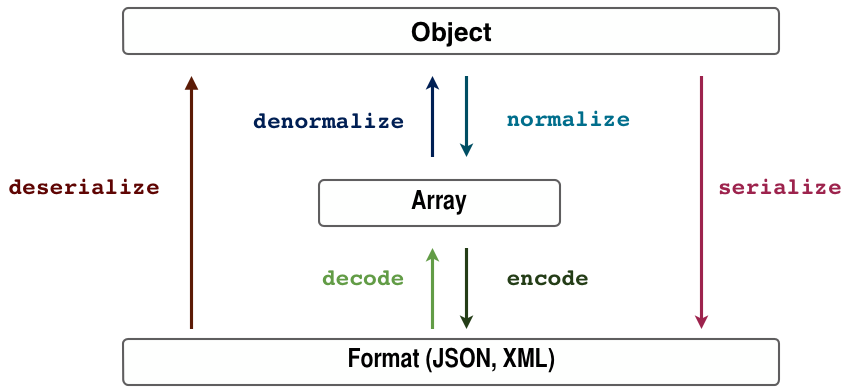.. index:: single: Serializer single: Components; Serializer
The Serializer Component is meant to be used to turn objects into a specific format (XML, JSON, Yaml, ...) and the other way around.
In order to do so, the Serializer Component follows the following simple schema.
As you can see in the picture above, an array is used as a man in the middle. This way, Encoders will only deal with turning specific formats into arrays and vice versa. The same way, Normalizers will deal with turning specific objects into arrays and vice versa.
Serialization is a complicated topic, and while this component may not work in all cases, it can be a useful tool while developing tools to serialize and deserialize your objects.
You can install the component in many different ways:
- Use the official Git repository (https://github.com/symfony/Serializer);
- Install it via PEAR ( pear.symfony.com/Serializer);
- Install it via Composer (symfony/serializer on Packagist).
Using the Serializer component is really simple. You just need to set up the :class:`Symfony\\Component\\Serializer\\Serializer` specifying which Encoders and Normalizer are going to be available:
use Symfony\Component\Serializer\Serializer; use Symfony\Component\Serializer\Encoder\XmlEncoder; use Symfony\Component\Serializer\Encoder\JsonEncoder; use Symfony\Component\Serializer\Normalizer\GetSetMethodNormalizer; $encoders = array(new XmlEncoder(), new JsonEncoder()); $normalizers = array(new GetSetMethodNormalizer()); $serializer = new Serializer($normalizers, $encoders);
For the sake of this example, let's assume the following class already exists in our project:
namespace Acme;
class Person
{
private $age;
private $name;
// Getters
public function getName()
{
return $this->name;
}
public function getAge()
{
return $this->age;
}
// Setters
public function setName($name)
{
$this->name = $name;
}
public function setAge($age)
{
$this->age = $age;
}
}
Now, if you want to serialize this object into JSON, you only need to use the Serializer service created before:
$person = new Acme\Person();
$person->setName('foo');
$person->setAge(99);
$serializer->serialize($person, 'json'); // Output: {"name":"foo","age":99}
The first parameter of the :method:`Symfony\\Component\\Serializer\\Serializer::serialize` is the object to be serialized and the second is used to choose the proper encoder, in this case :class:`Symfony\\Component\\Serializer\\Encoder\\JsonEncoder`.
Let's see now how to do the exactly the opposite. This time, the information of the People class would be encoded in XML format:
$data = <<<EOF
<person>
<name>foo</name>
<age>99</age>
</person>
EOF;
$person = $serializer->deserialize($data,'Acme\Person','xml');
In this case, :method:`Symfony\\Component\\Serializer\\Serializer::deserialize` needs three parameters:
- The information to be decoded
- The name of the class this information will be decoded to
- The encoder used to convert that information into an array
A popular third-party bundle, JMSSerializationBundle exists and extends (and sometimes replaces) the serialization functionality. This includes the ability to configure how your objects should be serialize/deserialized via annotations (as well as YML, XML and PHP), integration with the Doctrine ORM, and handling of other complex cases (e.g. circular references).
